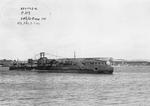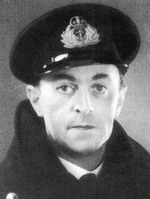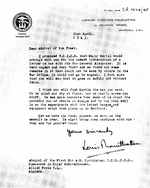Operation Mincemeat
Contributor: C. Peter Chen
ww2dbaseAt this stage of the war against Germany and Italy, it was apparent that the Allied forces were targeting southern Europe. While Sicily, Italy was decided to be the site of a major offensive, British MI5 intelligence agency planned Operation Mincemeat in an effort to create false alternative locations in the hope that the Axis leadership would be forced to divert troops to the wrong locations or minimally to spread the defenses thin. Royal Air Force intelligence officer Flight Lieutenant Charles Cholmondeley, assigned to MI5, conceived a plan which involved planting false documents on the body of a deceased man for this purpose of deception. His original idea was further developed by Royal Navy Lieutenant Commander Ewen Montagu, who refined the plan, which ultimately involved floating a body off of the coast of Huelva, Spain where the known German spy Adolf Clauss and the general favor the Spaniards had shown toward Germany both meant the captured false documents were likely to be passed on to the German leadership in Berlin.
ww2dbaseIn late 1942, Montagu consulted with the renowned pathologist Bernard Spilsbury to determine what kind of body would best be used for such an operation. On 24 Jan 1943, Welsh homeless man Glyndwr Michael was found dead in an abandoned warehouse in King's Cross, London, England, United Kingdom. He had died from ingesting rat poison which contained phosphorus; it was unknown whether he had committed suicide or simply ate what he thought was thrown-away food laced with the poison for the purpose of pest control. Montagu was informed of the discovery of this body, and despite the presence of phosphorus in the body and the yellowing of the skin due to the poisoning, the MI5 team decided that the body would convince the Spanish and the Germans that it was a victim of hypothermia or drowning. Coroner Bentley Purchase was convinced to break the law by certifying that Michael had died and was buried abroad, and transferred the body to MI5. The MI5 team then created a false identity, William "Bill" Martin, a temporary captain and acting major of the Royal Marines. Various artifacts such as his military identification card, a letter from his fiancée, a letter from his father, sales receipts, stubs to a show at a London theater, etc. were included on the body, while a briefcase of strapped onto the body, in which contained personal correspondences between high-ranking British and American officers hinting Kalamata, Greece and Sardinia, Italy as the targets of the next offensive, and that Sicily, Italy was to be a feint.
ww2dbaseOn 19 Apr 1943, British submarine HMS Seraph departed Holy Loch, Scotland, United Kingdom with the body of Glyndwr Michael, or the fictitious William Martin, aboard inside of a steel canister specially designed to continue to slow the decomposition of the body. On 30 Apr, the body was set in the water about one mile off of Huelva, Spain. While it was known that Spanish officials showed special favor toward the Germans, the British also knew the presence of Adolf Clauss, a German intelligence agent, in Huelva; both of these facts would help ensure the false information being forwarded on to Berlin. The body was set drift at 0430, and the submarine went out to deeper waters before attempting to sink the canister, which refused to sink even after being riddled by machine gun and cannon, thus a small explosive charge was used to destroy it; this unexpected turn did not alert Spanish civilians. At about 0930 hours, fisherman José Antonio Rey Maria discovered the body in the water and brought it back to Huelva. Spanish pathologist Eduardo Del Torno performed the post-mortem examination; while he discovered inconsistencies such as the advanced state of decomposition of the body, he nevertheless declared the body a victim of drowning, thus little suspicion, if any, was aroused.
ww2dbaseShortly after the discovery of the body off the Spanish coast, urgent messages were sent to the British naval attaché in Spain in an attempt to recover the documents carried by Martin. These messages were sent to purposely arouse Spanish and German suspicion that the documents contained military secrets. With the help of Lieutenant Colonel Ramón Pardo Suárez's men, the documents were opened, given to German Abwehr chief Wilhelm Leissner in Madrid to copy, and returned to the original envelopes, all with utmost care so that no sign of tempering would be left (the British did, however, later find the letters had been opened based on the way the letters curled when dried and the way the letters were originally folded and re-folded by the Spaniards). The text of the letters was immediately radioed to Berlin, and paper copies arrived a few days later.
ww2dbaseIn Berlin, Adolf Hitler knew of the close British-Greek relationship prior to the war, and had always been weary of an Allied invasion in Greece. These intercepted documents, with the false information hinting Kalamata, Greece as the next Allied target, fed what he wanted to believe. In response he moved divisions to the false invasion sites. When the actual invasion of Sicily, Operation Husky, was launched on 9 Jul, the Germans continued to wonder if the attack on Sicily was only a diversionary attack, as demonstrated by a squadron being dispatched to Sardinia from Sicily on the day of the invasion in search of targets.
ww2dbaseAlthough it was difficult to concretely quantify the degree success of this operation, it was determined that the deception was indeed successful. Ewen Montagu was made an Officer of the Order of the British Empire and Charles Cholmondeley was made a Member of the Order of the British Empire for accomplishing Operation Mincemeat.
ww2dbaseThe identity of Michael was unknown to the public until 1996 when amateur historian Roger Morgan found a recently declassified document which contained Michael's name. Michael's name was added to the gravestone in Huelva in Jan 1998.
ww2dbaseSources:
Ben Macintyre, Operation Mincemeat
Wikipedia
Last Major Update: Sep 2011
Photographs
 |  |  |  |
Operation Mincemeat Timeline
| 4 Jan 1909 | Glyndwr Michael was born in Aberbargoed, Wales, United Kingdom to a poor family. |
| 24 Jan 1943 | Glyndwr Michael, homeless and suffering from mental illness, was found dead in an abandoned warehouse in King's Cross, London, England, United Kingdom after consuming rat poison which contained phosphorus; it was unknown whether he had committed suicide or simply ate what he thought was thrown-away food laced with the poison for the purpose of pest control. The discovery of his remains was reported to MI5 per previous request for such a body. |
| 19 Apr 1943 | HMS Seraph departed Holy Loch, Scotland, United Kingdom with the body of Glyndwr Michael, dressed as Major William Martin and planted with false documents intended to mislead the Germans. |
| 30 Apr 1943 | The body of Glyndwr Michael was put into the sea from British submarine HMS Seraph off Huelva, Spain; posed as Major William Martin, the body carried false documents intended to mislead the Germans. |
| 4 May 1943 | The body of Glyndwr Michael was buried at the Cemetery of Solitude in Huelva, Spain as Major William Martin of the British Royal Marines. |
| 13 May 1943 | The false documents found on the body of Glyndwr Michael/William Martin was returned by the Spanish to the British, ostensibly unopened but actually shared with and photographed by the Germans. |
| 4 Jun 1943 | The Times newspaper in Britain reported the death of the fictitious Royal Marines temporary captain and acting major W. Martin. |
Did you enjoy this article or find this article helpful? If so, please consider supporting us on Patreon. Even $1 per month will go a long way! Thank you. Share this article with your friends: Stay updated with WW2DB: |
Visitor Submitted Comments
14 Nov 2017 12:20:47 PM
this is not true
22 Jul 2023 02:14:14 AM
https://alliedspecialforcesmemorialgrove.org/op-mincemeat
All visitor submitted comments are opinions of those making the submissions and do not reflect views of WW2DB.
» Spain
» United Kingdom
Related Books:
» Operation Mincemeat
» The Man Who Never Was
- » 1,150 biographies
- » 337 events
- » 43,917 timeline entries
- » 1,241 ships
- » 350 aircraft models
- » 207 vehicle models
- » 374 weapon models
- » 123 historical documents
- » 260 facilities
- » 470 book reviews
- » 28,541 photos
- » 432 maps
Joachim von Ribbentrop, German Foreign Minister, Aug 1939
Please consider supporting us on Patreon. Even $1 a month will go a long way. Thank you!
Or, please support us by purchasing some WW2DB merchandise at TeeSpring, Thank you!
17 May 2012 03:16:58 AM
what is the possibility that Glyndwr Micheals' name was placed in the file as a misdirection, in the full knowledge that the file would be declassified at sometime.